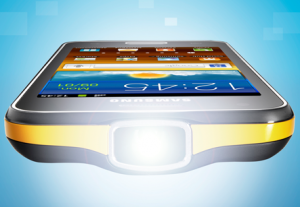aNewDomain.net — The DLP technology from Texas Instruments dominates the projector market, but a new tiny version released this week at IFA 2013 could lead the way to head-mounted displays and pocket projectors that could change how we think about viewing digital data in our everyday lives.
If you’re like me, you may be a bit jaded about “feeds and speeds” stories that talk about how devices are getting smaller or about how prices have dropped. I certainly think twice before writing up a piece like the one you’re reading now. But here is a unique case where I say mobile display technology has taken a significant step forward. We are on the way to major changes in the devices we use and the way that we use them. That’s thanks to DLP technology.
Texas Instruments did not need smoke – just mirrors – to dominate the projector market. Its TI DLP micro-mirror devices have become the basis for lightweight, high-resolution projectors used in applications ranging from conference rooms to home theaters. And now at IFA 2013 in Berlin, TI has released a stunning new TI DLP chip that could revolutionize mobile displays for portable devices as well.”
The specifications for this new chip show a Wide-VGA resolution imager with 854 by 480 pixels. This is not high-definition resolution, but it is sufficient for watching video or looking at snapshots. The traditional DLP technology relies on square mirrors that rock back and forth along a diagonal axis. This new chip adds “Tilt and Roll Pixel” technology that was introduced at CES 2013; the mirrors pivot around the vertical axis.
The new DLP chipset from TI uses “tilt and roll pixel” technology that deflects the mirrors along two axes.
Image Credit: Texas Instruments
According to TI, the result is a device that can deliver 100 percent more light while using half as much power. And the chipset is a mere 0.21 inches diagonal; that’s small enough to fit three of them diagonally across the face of a dime, with room to spare.
By now you should be asking: So what?
So what?
Hey, this is an important development. Tiny imagers will soon be ubiquitous. The buzz about Google Glass and new smart watches is really just about our desire to have more access to digital information in more places and in more natural ways.
Tiny imagers can fill these roles in ways that fixed, direct-view, flat panels such as LCD and OLED cannot. One example: A small projector sending an image to a beam splitter on your glasses – such as Google Glass – that in turn lets you interact with your data feeds while also staying in direct contact with your surroundings.
The same small package also makes it possible to create devices that can project a larger image that can be shared with many people at once.
The Samsung Galaxy Beam, shown below, was an early entry in the category of smartphones with built-in projectors. And as solid-state light sources get brighter and more efficient, these designs may become more practical.

Smartphones with built-in projectors like the Samsung Galaxy Beam make it easier for several people look at an image or video at the same time.
Image Credit: Texas Instruments
And then there are the applications we’ve yet to see on a significant scale.
Think about it. A tiny projector has advantages over flat panels for car dashboard displays — they’re also employable as heads-up displays that project images onto the inside of a car’s windshield.
The bottom line is that this new imaging chip is smaller, brighter, and more energy efficient. And it has a useful resolution. We’ll soon find it in products that will change our lives — by that time, no one will remember the acronym DLP, but that is how the future rolls.
For aNewDomain.net, I’m Alfred Poor.
Based in bucolic Bucks County PA, Alfred Poor is a senior technologist here at aNewDomain.net. A 30-year tech journalism vet, he’s internationally renowned for his coverage of displays. He is easily distracted by shiny, sparkly gadgets and that’s why he is covering consumer tech for us, too. Contact Alfred at Alfred@aNewDomain.net, follow him @AlfredPoor and find the +Alfred Poor Google+ stream here. Alfred also is a professional speaker, a bluegrass musician and a sailor. Check out his LinkedIn profile for more.














